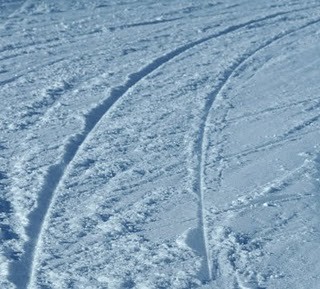
When shaped skis made their debut skiers quickly
discovered how much fun it was to lay them over and ride the side cut. The skis
made it easy to ski reasonably well with little effort. However, skiers were no
longer working the ski, they were instead just “railing it”.
In the last couple of years the term “railing it”
has come to mean something much more positive. Rather than the park and ride –
getting on your edges and hanging out until your ski comes around -“railing it”
now refers to working the ski in order to leave two clean arcs in the snow from the top of the turn all
the way through the transition to the next turn. While the old way of railing
it left you at the mercy of the radius of your ski, with the new way of railing
it you control the size of your turn.
What makes railing it different than an ordinary
intermediate parallel turn is that you are controlling the amount you steer
without pivoting per se. How then do you dictate the radius of your turn? By
building enough energy to bend your ski.
Easy enough said but how do you do that? To initiate edging early you need to balance over your new outside ski immediately after you finish your last turn. A good way to practice this is to skate ski on an easy run or trail and then link the skate ski push into the beginning of your new turn. Start your turn by inclining your ankles, knees, then hip all before the fall line. Railed turns are large turns so the hip joint quickly follows the ankles and knees at the top of the turn leaving some room for the smaller joints (ankles and knees) to further move inside to add some “oomph” at the end of the turn. With all of the lower joints inclining into the turn, remember to keep the upper body angulated to the outside of the turn/down the hill to allow you to balance over your outside ski.
To rail it you need to build up speed to bend
your skis so go on terrain where you feel comfortable going fast - minimum
terrain + maximum speed. Think about leaving two clean lines on the snow. On a
day where it’s easy to see your tracks, you can see how well you did by simply
looking back up the hill once you’ve stopped.
Now, words I never thought I’d hear a ski
instructor say, get out there and rail it!
